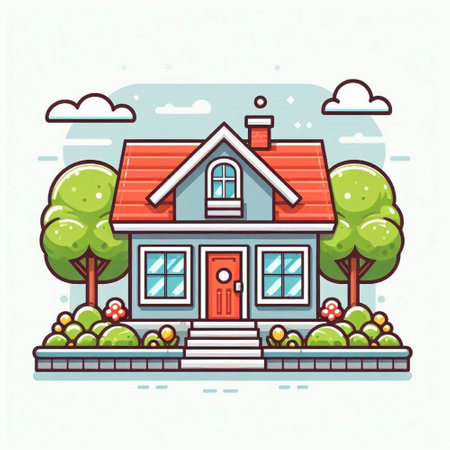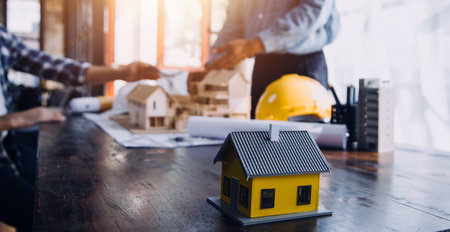1. Curb Appeal and First Impressions
When it comes to buying a home, first impressions matter—a lot. Buyers often form immediate opinions based on a homes exterior, sometimes within seconds of pulling up to the curb. This emotional response can set the tone for the entire showing. A well-kept front yard, tidy landscaping, and a welcoming entryway signal that the home has been cared for, which builds trust and interest.
Why Curb Appeal Matters
Think of curb appeal as the packaging of a product. Even before buyers step inside, theyre already deciding if they feel connected to the property. That connection is driven by visual appeal and subtle emotional cues like cleanliness, symmetry, and attention to detail.
Key Elements That Influence First Impressions:
| Feature | Impact on Buyer Psychology |
|---|---|
| Landscaping | A neat lawn, trimmed bushes, and colorful flowers suggest pride in ownership. |
| Walkways & Driveways | A clean, crack-free path makes the home feel safe and well-maintained. |
| Front Door & Entryway | A freshly painted door with new hardware feels inviting and secure. |
| Lighting | Outdoor lighting highlights features and adds warmth during evening showings. |
Simple Fixes That Make a Big Difference:
- Mow the lawn regularly and remove weeds
- Add potted plants or seasonal decorations near the entrance
- Power wash siding, walkways, and driveways
- Replace outdated house numbers or mailbox
The goal is to create a space that feels loved and lived in—but not worn out. When buyers see a well-maintained exterior, they imagine themselves taking pride in ownership too. Its not just about looks—its about creating an emotional connection right from the start.
2. Layout and Flow of the Home
Today’s homebuyers are not just purchasing a property—they’re investing in a lifestyle. One of the first things buyers notice when walking through a home is how the space feels, connects, and flows. An open and intuitive layout helps buyers imagine themselves living in the home comfortably and efficiently.
Open-Concept Living Is In Demand
Modern buyers often prefer open-concept designs where the kitchen, dining area, and living room blend into one shared space. This setup encourages interaction among family members and guests, making it ideal for both everyday living and entertaining. Walls that separate rooms can make a home feel smaller or more outdated, while an open layout creates a sense of spaciousness and flexibility.
Functional Floor Plans Matter
The way rooms are positioned plays a big role in how buyers perceive value. A functional floor plan supports modern routines—think of easy access from the garage to the kitchen for unloading groceries, or having a guest bathroom near common areas. Homes with awkward layouts or inefficient use of space often leave buyers feeling frustrated or disconnected.
Key Features Buyers Look for in Layouts:
| Feature | Why It Matters |
|---|---|
| Open Kitchen/Living Space | Makes the home feel larger and fosters family connection |
| Main Floor Primary Suite | Adds convenience and appeals to multi-generational households |
| Mudroom or Drop Zone | Keeps clutter out of main living areas; practical for families |
| Smooth Room Transitions | Makes movement throughout the home feel natural and seamless |
| Zoned Living Areas | Cater to different needs—quiet workspaces vs active family zones |
A Layout That Matches Lifestyle
Diverse lifestyles mean different layout preferences. For example, young professionals might prioritize open entertaining spaces, while families may value defined zones for kids’ activities and quiet homework areas. By understanding what type of buyer your home may attract, you can better position it to meet their expectations.
The Bottom Line on Flow
If buyers feel like they have to “figure out” how to live in a space, they’re less likely to move forward. A well-thought-out layout makes it easy for them to mentally move in—an emotional step that often leads directly to offers.

3. Updated Kitchens and Bathrooms
When it comes to buying a home, updated kitchens and bathrooms are at the top of most buyers wish lists. These are two of the most scrutinized areas in any home because they reflect not only the homes functionality but also its style and upkeep. A modern kitchen or bathroom can create an instant emotional connection with buyers, making them more likely to envision themselves living there.
Buyers today look for kitchens that are both beautiful and practical. Think stainless steel appliances, quartz or granite countertops, ample cabinet space, and good lighting. An open-concept layout that connects the kitchen with dining or living areas is also a big plus, as it supports todays lifestyle centered around entertaining and family time.
Bathrooms, on the other hand, are expected to offer comfort and a touch of luxury. Features like walk-in showers with glass enclosures, double vanities, modern tile work, and even freestanding tubs can make a big impact. Spa-like elements signal relaxation and self-care—something that resonates strongly with many buyers.
What Buyers Love to See
| Kitchens | Bathrooms |
|---|---|
| Stainless steel appliances | Walk-in showers |
| Quartz or granite countertops | Double vanities |
| Subway tile backsplashes | Modern tile flooring |
| Large islands with seating | Spa-style tubs |
| Pendant lighting over islands | Updated fixtures & lighting |
The psychology behind this is simple: buyers associate updated kitchens and bathrooms with less immediate maintenance and added value. They feel more confident about moving into a home where these rooms don’t need immediate work. In fact, many are willing to pay more for homes that already have these upgrades in place because it saves them time and money down the road.
4. Natural Light and Bright Interiors
A well-lit home is not only more visually appealing, but it also feels more spacious and welcoming. Many homebuyers in the U.S. prioritize natural light as a key feature when searching for a new place. It gives the impression of cleanliness, openness, and comfort—qualities that can make or break their first impression.
What Buyers Are Looking For
Homebuyers tend to favor properties that feel airy and bright. This doesnt just come from having windows—it’s about how the entire space works together to enhance lighting. Here are some of the top features buyers pay attention to:
| Feature | Why It Matters |
|---|---|
| Large Windows | Let in natural sunlight and provide views that connect indoor spaces with the outdoors. |
| Light Paint Colors | Reflect light better, making rooms feel bigger and more inviting. |
| Open Floor Plans | Allow light to flow freely through the space without walls blocking it. |
| Strategic Lighting Fixtures | Add brightness where natural light is limited, such as hallways or basements. |
Simple Ways to Enhance Light in Your Home
You don’t always need major renovations to improve lighting. A few small changes can make a noticeable difference:
- Use mirrors to reflect natural light across the room.
- Replace heavy curtains with sheer window treatments.
- Repaint dark walls with soft neutrals like white, beige, or pale gray.
- Add layered lighting—think ceiling lights combined with floor lamps and under-cabinet lighting.
Understanding how buyers respond to bright interiors helps sellers present their homes in a way that attracts more interest and potentially higher offers. When a home feels naturally lit and open, it instantly becomes more desirable in the eyes of many potential buyers.
5. Neighborhood and Community Factors
When buyers are house hunting, they’re not just looking at the property—theyre also evaluating the neighborhood. In fact, for many people, the area around the home is just as important as the home itself. Things like good schools, low crime rates, nearby parks, and a welcoming community can heavily influence buying decisions.
Why the Neighborhood Matters
Homebuyers often picture their future lifestyle when touring homes. They ask themselves: “Can I see myself living here?” That vision includes more than the kitchen layout or backyard size—it involves their daily routines, safety, and social life. Whether its walking the dog in a safe neighborhood or sending kids to a top-rated school, these factors matter.
Main Community Factors Buyers Consider
| Community Factor | Why It Matters to Buyers |
|---|---|
| Proximity to Good Schools | Parents want access to quality education without long commutes. Homes near top-rated schools often retain value better over time. |
| Safe Streets | A low crime rate is essential for peace of mind and raising a family. Buyers often check crime statistics before making offers. |
| Local Amenities | Parks, grocery stores, gyms, and restaurants within close reach make day-to-day life more convenient and enjoyable. |
| Sense of Community | A friendly neighborhood where people know each other adds emotional value and makes people feel more connected and secure. |
The Bigger Picture: Quality of Life Over Square Footage
A large house might seem appealing at first glance, but many buyers would trade extra space for better schools or a vibrant local community. They’re thinking long-term—how will this location impact their lifestyle and investment? A smaller home in a great area often wins over a bigger house in a less desirable location.
6. Emotional Connection and Vision Potential
When buyers walk into a home, they’re not just looking at square footage or the number of bedrooms—theyre imagining their future lives in that space. This emotional connection plays a huge role in their decision-making process. A home that feels too personal or cluttered can make it harder for potential buyers to picture themselves living there.
Why Neutral Spaces Matter
Neutral, de-personalized interiors help create a blank canvas. When the walls are painted in soft tones, and the décor is minimal and tasteful, it allows buyers to focus on the homes features instead of being distracted by someone elses lifestyle or taste.
This doesn’t mean a home should feel cold or empty—it should still feel warm and inviting. The goal is to strike a balance between cleanliness, comfort, and neutrality.
How Personalization Can Affect Buyer Perception
| Highly Personalized Home | Neutral-Styled Home |
|---|---|
| Family photos on every wall | Simple artwork or mirrors |
| Bold paint colors | Soft, neutral tones like beige or light gray |
| Themed rooms (e.g., sports team room) | Flexible spaces open to interpretation |
The Power of Visualization
Buyers want to imagine where their furniture will go, how theyll host guests in the living room, or what Sunday mornings might look like in the kitchen. If a home is too personalized, it creates mental barriers that prevent this type of visualization.
Tips to Boost Vision Potential:
- Remove personal photographs and memorabilia
- Keep décor simple and minimal
- Declutter countertops and shelves
- Use neutral bedding and towels in bedrooms and bathrooms
- Stage rooms with basic furniture to define purpose without overwhelming the space
A home that offers emotional appeal while leaving room for imagination can leave a lasting impression—often turning a casual showing into a serious offer.

